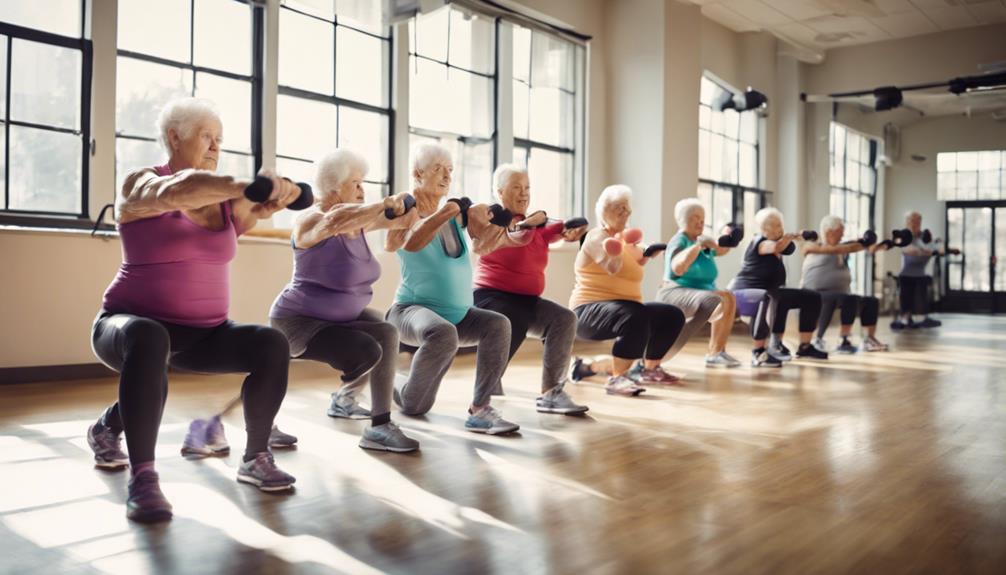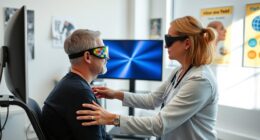Bed and chair alarms are effective in preventing falls by quickly alerting caregivers for timely assistance. These alarms are crucial for ensuring safety and minimizing fall risks. Both types of alarms prompt caregivers to respond promptly to potential falls. However, challenges such as alarm fatigue and false alarms may arise. To better understand how bed and chair alarms operate and their role in fall prevention, continue reading to explore more details about their effectiveness and potential concerns.
Key Takeaways
- Bed and chair alarms play a crucial role in alerting caregivers to prevent falls effectively.
- They prompt timely assistance and rapid intervention, reducing fall risks.
- Nurse perception of alarm fatigue exists, but alarms remain pivotal for patient safety.
- Balancing safety and autonomy is essential in implementing alarm systems.
- Effective fall prevention strategies should include tailored interventions beyond traditional alarms.
Effectiveness of Bed Alarms in Hospitals
Bed alarms in hospitals play an essential role in supporting fall prevention plans by alerting staff to patients attempting to leave their beds. These alarms serve as a pivotal tool in guaranteeing the safety of patients, especially those who are at a higher risk of falling. By promptly alerting the staff when a patient is trying to get out of bed unsafely, bed alarms enable rapid response and intervention, ultimately preventing potential falls. While bed alarms aren't a substitute for direct supervision, they serve as an additional layer of protection for patients in hospital settings.
Implementing bed alarms is a low-cost intervention that has shown effectiveness in preventing falls, particularly among slow-moving or frail patients. The alarms act as a constant reminder for patients to avoid ambulating independently, reducing the risk of falls. Additionally, the rapid response information provided by these alarms equips staff with the necessary tools to intervene promptly and ensure patient safety. By incorporating bed alarms into fall prevention plans, hospitals can enhance their overall patient care and safety protocols.
Impact of Chair Alarms on Fall Prevention

In hospitals, the incorporation of chair alarms as part of fall prevention strategies has been instrumental in enhancing patient safety and reducing the risk of falls. Chair alarms serve as reminder devices that alert caregivers when elderly or at-risk patients attempt to leave their chairs, prompting timely assistance and reducing the likelihood of falls.
Studies have shown that proper implementation of chair alarms can greatly improve response time and help reduce the risk of falls in healthcare settings. It's important to understand that chair alarms aren't restrictive devices; instead, they're designed to support patients by reminding them to seek assistance before standing, promoting a safer environment.
Nurse Perception of Alarm Fatigue
When we talk about Nurse Perception of Alarm Fatigue, it's vital to contemplate the challenges presented by alarm desensitization and delayed responses. Nurses may feel inundated by constant alerts, impacting their prioritization and response effectiveness.
Tackling these issues through staff training is pivotal for upholding the effectiveness of bed and chair alarms in fall prevention efforts.
Alarm Fatigue Challenges
Amidst the constant clamor of false alarms, nurses in healthcare settings often find themselves grappling with alarm fatigue, a phenomenon that can desensitize and hinder their responsiveness to genuine fall risks. The overwhelming presence of alarms can lead to desensitization among nursing staff, impacting their ability to provide quality care and respond promptly to patient needs.
Alarm fatigue poses a significant challenge to patient safety, as delayed responses to actual fall risks may occur due to the sheer volume of alerts. It's essential for healthcare facilities to implement strategies to mitigate alarm fatigue, ensuring that nurses remain vigilant and alert in identifying and addressing genuine fall hazards promptly.
Effective management of alarm systems is crucial to maintaining a high standard of care and safeguarding patients from potential harm.
Staff Training Needs
Addressing staff training needs is crucial in combating nurse perception of alarm fatigue and ensuring prompt responsiveness to bed and chair alarms. Nurse responsiveness can be hindered by high false alarm rates, leading to a decreased ability to meet patient needs effectively.
Proper staff training plays an important role in helping nurses distinguish between false alarms and genuine emergencies, reducing alarm fatigue and enhancing patient care. By educating staff on alarm system functionalities, appropriate responses, and strategies to prioritize alarms, hospitals can empower nurses to navigate alarm situations efficiently.
Training programs should emphasize the importance of staying alert, maintaining composure during alarm activations, and responding promptly to guarantee patient safety. Through thorough staff training, healthcare facilities can mitigate alarm fatigue issues and optimize nurse responsiveness to alarms.
Concerns About False Alarms
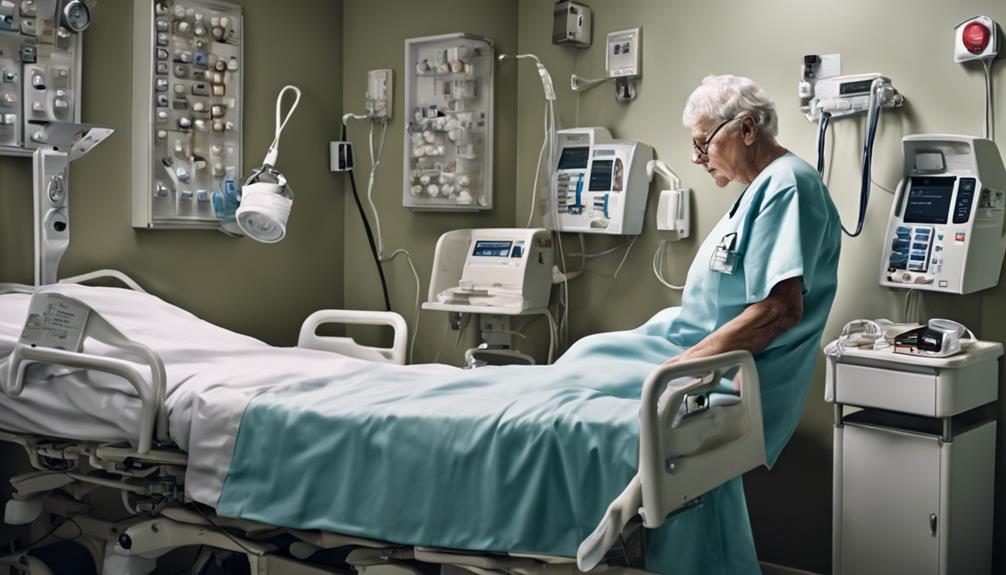
False alarms in bed and chair alarms are a common issue, making up a significant portion of total activations. These false alarms can lead to alarm fatigue among caregivers, potentially desensitizing them to genuine risks.
Consequently, addressing false alarm concerns is essential to ensuring the effectiveness of fall prevention strategies.
False Alarm Frequency
Managing the frequency of false alarms is vital to maintaining the effectiveness of bed and chair alarms in fall prevention strategies. False alarms, which occur in about 32% of cases, can lead to alarm fatigue among caregivers. These false alarms may desensitize staff, reducing their responsiveness to real fall risks.
High false alarm rates can also result in staff complacency, impacting their ability to react promptly to actual emergencies. By effectively managing false alarms, we can optimize the use of bed and chair alarms in preventing falls.
It's essential to address this issue to make certain that these alarms serve their purpose in enhancing safety and reducing the occurrence of fall-related incidents.
Impact on Staff
How do frequent false alarms from bed and chair alarms impact the responsiveness and alertness of healthcare staff in preventing falls?
False alarms can lead to alarm fatigue, reducing staff's ability to respond promptly to genuine fall risks.
Increased false alarms raise staff workload, potentially diverting attention from actual patient safety concerns.
Staff may become desensitized to alarms due to the high frequency of false alerts, compromising the effectiveness of fall prevention measures.
Balancing Safety and Autonomy
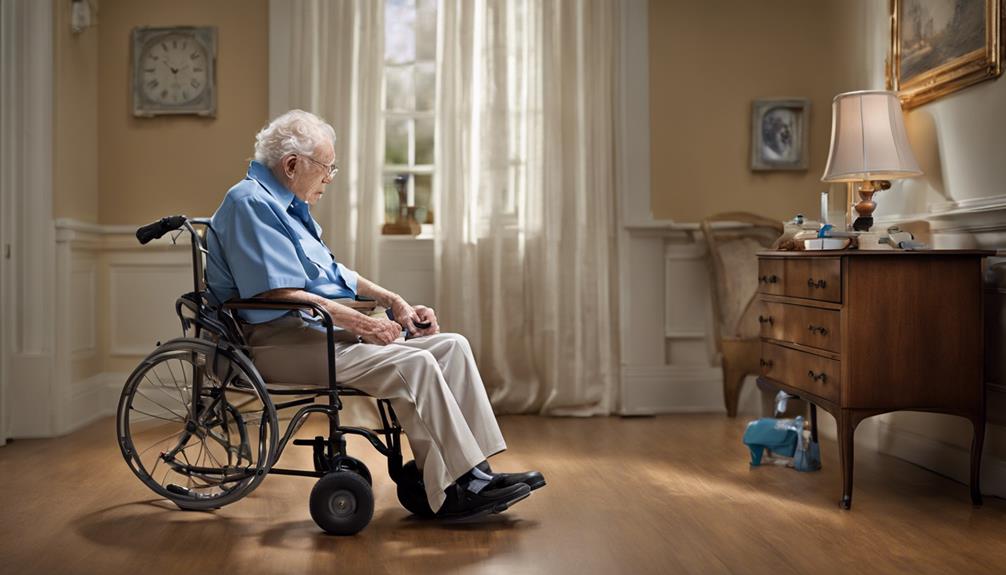
Balancing patient safety with the preservation of autonomy poses an essential challenge in the implementation of bed and chair alarms for fall prevention. It is important to contemplate both the well-being of the patient and their right to make choices about their own care. This balance necessitates nurses to navigate ethical dilemmas, ensuring that safety measures do not compromise patient dignity or independence.
| Challenges | Solutions |
|---|---|
| Limiting patient autonomy | Educate staff on the significance of autonomy and involve patients in care planning. |
| Alarm fatigue among staff | Provide training on alarm system usage and maintenance to reduce false alarms. |
| Ethical dilemmas | Encourage open communication between healthcare providers, patients, and families to address concerns. |
Finding this equilibrium is essential in preventing falls in hospitalized patients effectively. Proper training and education play a critical role in ensuring that alarm systems are used appropriately without infringing on patient autonomy. By fostering a culture of respect and understanding, healthcare providers can enhance patient safety while upholding individual autonomy.
Research on Fall Prevention Strategies

In addressing the challenges of bed and chair alarms for fall prevention, it's important to contemplate the findings from research on effective strategies in preventing falls among hospitalized patients.
Research shows that while bed alarms can alert caregivers to bed-exit attempts in elderly patients at risk of falls, they don't notably reduce the overall number or rate of falls in healthcare settings. This raises concerns about alarm fatigue among nurses due to the high rate of false alarms, impacting both their morale and performance.
Additionally, unrealistic expectations of achieving zero falls solely through alarm systems can lead to ethical concerns regarding patient autonomy. To enhance fall prevention strategies, healthcare facilities should consider a holistic approach that combines alarm systems with other interventions tailored to individual patient needs.
This approach can help mitigate alarm fatigue, improve nurse morale, and uphold ethical standards while promoting patient safety and autonomy.
Challenges in Healthcare Settings
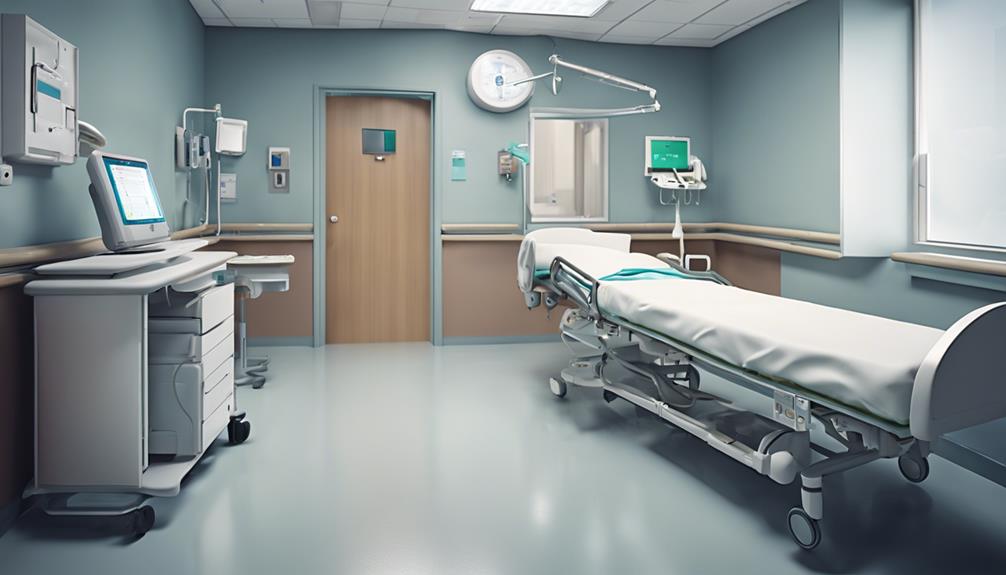
Amid the complex dynamics of healthcare settings, we encounter various challenges associated with implementing bed and chair alarms for fall prevention. Alarm fatigue, a common issue among healthcare providers, can arise due to the high rate of false alarms, potentially reducing the effectiveness of these alarm systems in preventing falls. Additionally, concerns about patient autonomy and independence may surface when relying heavily on alarms, impacting the overall care provided. Overreliance on these alarms can also create a false sense of security, leading to a neglect of other important fall prevention strategies.
Healthcare providers face the demanding task of balancing the benefits of alarm systems with the potential negative impacts on patient care and staff workload. Proper training and education are essential to guarantee the effective implementation of bed and chair alarms in healthcare settings. By understanding these challenges and addressing them proactively, healthcare professionals can work towards enhancing patient safety while minimizing the drawbacks associated with alarm systems.
Future Directions for Fall Prevention

To enhance patient safety and advance fall prevention strategies, we'll explore innovative interventions beyond traditional bed and chair alarms.
- Implementing combined interventions that incorporate various strategies such as exercise programs, environmental modifications, and staff education can greatly enhance fall prevention efforts.
- Leveraging innovative technologies like wearable sensors or smart monitoring systems can help address alarm fatigue and improve the accuracy of fall detection, ultimately reducing the risk of falls.
- Engaging interdisciplinary teams comprising healthcare professionals, caregivers, and patients in the development of personalized fall prevention plans can lead to more effective and tailored strategies to mitigate fall risks.
Frequently Asked Questions
Do Bed and Chair Alarms Prevent Falls?
Bed and chair alarms prompt timely intervention by alerting caregivers when patients try to leave their beds, aiding in fall prevention. While not independently preventing falls, these alarms are valuable tools when integrated into a broader strategy.
What Are the Disadvantages of Bed Alarms?
While bed alarms aim to enhance safety, drawbacks include alarm fatigue, increased burden, cost implications, and autonomy restrictions. Overreliance on alarms may create a false sense of security, neglecting holistic fall prevention strategies.
What Is the Most Effective Method for Preventing a Fall?
In preventing falls, the most effective method involves a all-encompassing approach. Targeted interventions, all-inclusive programs, and education with patient involvement are key. Rather than relying solely on alarms, a holistic strategy yields better outcomes.
Why Do Some Facilities Not Use Chair Bed Alarms?
Some facilities may not use chair bed alarms due to concerns about alarm fatigue among caregivers. Lack of proper training and education on their use can lead to underutilization. Cost implications and inconsistencies in evidence also play a role.
Conclusion
In summary, bed and chair alarms can be effective tools in preventing falls in healthcare settings. However, like any tool, they have limitations and may not be foolproof. It is important to recognize that alarms should be used as part of a comprehensive fall prevention strategy rather than the sole solution. Additionally, healthcare providers must consider individual patient needs and explore other interventions to enhance safety and wellbeing. For instance, addressing underlying conditions such as sleep disturbances with effective treatments for sleep apnea could also contribute to improved patient outcomes and reduce fall risks.
It's important to remember that these alarms are just one part of a thorough fall prevention strategy. Like a seatbelt in a car, they provide an added layer of protection, but shouldn't be relied on solely.
It's vital to balance safety measures with the individual's autonomy and dignity.



